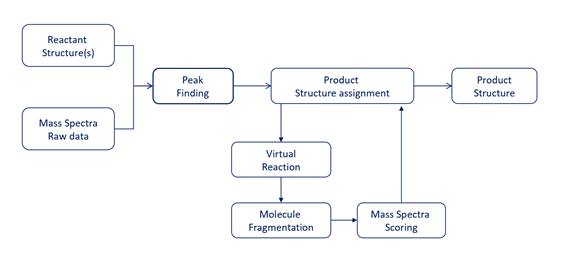Information
Peak Finding, Structure Elucidation and SoM Prediction.
MassMetaSite, first translates the data into a common format standardizing all different types of data input formats. Secondly, the system performs an automatic peak finding using several proprietary algorithms that consider the signal/noise analysis, blank comparison, compound fragmentation, isotope filtering, mass defect analysis and chromatogram front and tail analysis. After all these algorithms are applied several chromatographic peaks related to the compound of interest are obtained. These peaks are characterized by their retention time range, m/z observed and the MS2 or secondary spectra. In parallel the system computes the structure of all the metabolites that can be formed applying the chemical rules of the metabolic transformations generation a pool of potential structures that are characterized by the structure, their calculated m/z and their potential fragmentation. The system in the third step assigns the structures to the chromatographic peaks found and assigning a color to each peak:
- Green: This peak color is obtained when the observed m/z can be reached by the metabolite structure calculated m/z computed using a single generation of the metabolic transformation.
- Brown: This peak color is obtained when the observed m/z can be reached by the metabolite structure calculated m/z computed using two or more generations of the metabolic transformation, i.e., metabolite of metabolite.
- Light blue: This peak color is obtained when the observed m/z can be reached only by computing the selected adducts, dimers or neutral losses to the first or more generation of the metabolite or the parent.
- Pink: This color is obtained if the peak is only detected in the UV chromatogram and no peak can be assigned using in the MS spectra the UV parameters.
- Orange: This color is obtained if the peak is only detected in the Fluorescence chromatogram and no peak can be assigned in the MS spectra using the Fluorescence parameters.
- Black: This color is obtained if the peak is only detected in the Radio chromatogram and no peak can be assigned in the MS spectra using the Radio parameters.
In the fourth step, each computed structure that is assigned to each peak will be scored in agreement with the fragmentation analysis. This process starts with the fragment assignation made for the parent by comparing the theoretical fragments obtained by breaking and reorganizing the bonds in the parent structure and the observed MS and MS2 m/z signals from the spectra.
These assigned fragments for the parent are then compared with the potential fragmentation of the metabolite structure using the same breaking rules used for the parent. In this case the fragments found in the metabolites that are shift or non-shifted compared to the parent ones, or the fragments that are only found in the analysis of the peak spectra and the structure of the metabolite will count as positive in the scoring. The structural fragments of the metabolites that are not compatible with the m/z observed will count as negative in this scoring system. The solutions that have the same scoring will be grouped in a Markush representation.
The final step for the process is the computation of the Site of Metabolism score (SoM), each metabolite structure is associated to the modification of a set of atoms in the parent one, and each atom of the parent has a MetaSite scoring procedure that it is used to rank the solutions that have the same Mass Spec score.

